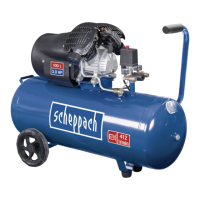international 27
wise. In order to reduce the air pressure, turn the valve
anti-clockwise.
Attention: The absence of air ow during setting pro-
duces an incorrect display. For a correct display, air must
ow.
5 Upon termination of your work, or when you leave the
compressor unattended, switch it off as follows:
• Press the ON/OFF switch (3).
• Wait until the compressed air has escaped via the drain
valve under the switch cover (2).
Attention: On pressing the button you should hear a
short air exit (about half a second).
Fig. 9
• Switch the machine off and pull the mains plug.
• Pull the ring on the safety valve (8) in order to make
sure that the compressed air has escaped from the
tank, or open the drain plug of the tank in order to let
the pressure escape.
Maintenance
Warning: For any and all maintenance and cleaning,
please shut the engine off and unplug the device.
Fig. 10 and 11
1 Following the rst ten hours of operation, empty the oil
from the crankcase and rell it with clean oil. To this
end, remove the sealing plug on the crankcase (at the
bottom left of the crankcase).
Attention: SAE 30 or L-DAB 100 above 10 °C,
SAE 10 or L-DAB 68 below 10 °C.
2 After every 500 operating hours, drain the oil and ll
the crank box with clean oil.
3 After every operating day, drain the condensate from
the tank using the drain plug (11).
4 Check the air lter cartridges inside regularly. Remove
the air lter cover (A) from the housing by turning it
slightly and clean the lter (B). After cleaning the lter,
re-insert it and close the cover.
Caution! Never operate the compressor without air
lter.
5 Before every startup of the machine, check the function-
ing of the safety valve. When checking, the tank must
read at nearly maximum pressure.
For checking the valve, set the tank under pressure and
pull the ring on the safety valve to the outside.
There should be air escaping from the valve.
At releasing the ring from the safety valve, the escaping
air must stop.
Warnings
For this test goggles must be worn. Do not hold your face
close to the safety valve as there the air escapes at a
high pressure.

